| Bear Gulch Limestone | |
|---|---|
| Stratigraphic range: Late Serpukhovian (Namurian E2b), 324 Ma PreꞒ Ꞓ O S D C P T J K Pg N ↓ | |
 Echinochimaera meltoni, one of many unusual chondrichthyans found in the Bear Gulch Limestone Echinochimaera meltoni, one of many unusual chondrichthyans found in the Bear Gulch Limestone | |
| Type | Lens |
| Unit of | Heath Formation |
| Thickness | 30-40 meters |
| Lithology | |
| Primary | limestone, shale |
| Other | siltstone |
| Location | |
| Coordinates | 46°57′N 109°00′W / 46.95°N 109°W / 46.95; -109 |
| Country | |
| Extent | |
| Type section | |
| Named for | Bear Gulch, Montana |
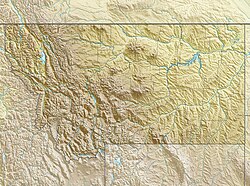 | |
The Bear Gulch Limestone is a limestone-rich geological lens in central Montana, renowned for the quality of its marine fossils from the late Mississippian subperiod, about 324 million years ago. It is exposed over a number of outcrops northeast of the Big Snowy Mountains, and is often considered a component of the more widespread Heath Formation. The Bear Gulch Limestone reconstructs a diverse, though isolated, marine ecosystem which developed near the end of the Serpukhovian age in the Carboniferous period. It is a lagerstätte, a particular type of rock unit with exceptional fossil preservation of both articulated skeletons and soft tissues. Bear Gulch fossils include a variety of fish, invertebrates, and algae occupying a number of different habitats within a preserved shallow bay.
Fish include a high diversity of unusual chondrichthyans (cartilaginous fish) and one of the oldest known lampreys, along with other vertebrates. Invertebrates include numerous fossils of crustaceans, worms, cephalopods, and sea sponges, which are concentrated in different parts of the bay basin. Shelled cephalopods are abundant, and the Bear Gulch Limestone also preserves some of the best early fossils of coleoid cephalopods. Fossils of typical benthic (seabed-attached) organisms are rare, and those that do occur are restricted to reef-like sponge patches in eastern exposures. This indicates that the conditions of the bay responsible for the Bear Gulch Limestone were at odds with other marine areas nearby.
Some Bear Gulch fossils were preserved so rapidly and efficiently that mating behaviors, internal organs, coloration patterns, gut content, and even the pattern of blood vessels could be observed in fossils. This exceptional preservation may be a consequence of the prevailing warm monsoonal climate, as storms could frequently and rapidly cover the seabed with oxygen-poor organic runoff from shallower areas. Although up to 40 meters of sediment are found in the Bear Gulch Limestone, biostratigraphic data suggests that the lens was emplaced in only 1000 years, a geological instant.
Geology
Geological setting
The Bear Gulch Limestone is commonly considered to be part of the Heath Formation, the youngest formation in the Big Snowy Group of central Montana. Some authors instead consider the Bear Gulch Limestone to be an early member of the Tyler Formation, a patchy but widespread unit of Carboniferous limestone and terrestrial sediments. Most of the Heath Formation is represented by black shales and marls, indicative of brackish and salty littoral environments. It developed along a transgressive sequence in a narrow saltwater seaway, known as the Central Montana Trough or Big Snowy Trough. This seaway flowed into the Williston Basin, a shallow inland sea further east. The Central Montana Trough would have also been linked to fully marine basins on the western coastline of Laurussia, but this connection may have been broken by the time of the Bear Gulch Limestone's deposition.
Many distinct limestone lenses (localized sediment packages) are developed in the Heath Formation. They overlap each other in an east-to-west sequence which extends over a distance of 160 km in the Central Montana Trough. The only exposed portions of the sequence are found at Potter Creek Dome, a small uplifted area northeast of the Big Snowy Mountains. The last few limestone lenses form a large portion of the Upper Heath Formation, which is sometimes termed the Bear Gulch Member in recognition of the most well-exposed and fossiliferous lens in the sequence. This lens, the Bear Gulch Limestone, was also one of the last in the sequence, only succeeded by the Surenough Beds immediately west of it. The Bear Gulch Limestone can be observed in numerous outcrops, spread out over an area of more than 50 km2 in Fergus County, Montana.
The creation of limestone lenses in the Heath Formation has been linked to tectonic activity extending the seaway by excavating bays out of the surrounding land. As old bays are filled in and buried by sediment, faulting and seismic events form new bays in a long eastward to westward succession. It may have taken a mere 1000 years for the bay responsible for the Bear Gulch Limestone lens to fill in completely, after only 25,000 years for the entire bay formation sequence to run its course across Montana. The final limestone deposits in the area were succeeded by freshwater lake sediments of the Cameron Creek Formation, the oldest unit of the early Pennsylvanian-age Amsden Group.
Age
A wide variety of biostratigraphic evidence places the Heath Formation in the upper part of the Chesterian stage, near the end of the Mississippian subperiod (early Carboniferous period). The upper Chesterian is the North American regional equivalent to the global Serpukhovian stage, as well as the lower part of the European Namurian stage. The Bear Gulch Limestone in particular is correlated with ammonoid zone E2b (middle Arnsbergian) of the Namurian, not far from the top of the Serpukhovian. Strata from zone E2b in England and the Czech Republic have been dated to around 324 million years ago.
Climate
During the time of deposition, the area was about 10-12 degrees north of the equator, on the boundary between the arid subtropics and tropical equatorial region. Cyclical deposition supports a climate model arguing that the overall climate was warm and monsoonal, with pronounced rainy and dry seasons. During the quiet dry season, sedimentation was low and the basin would have been influenced by northeasterly trade winds, tidal currents, and evaporation. Early in the rainy season, warmer temperatures and reduced trade winds would have isolated the basin and increased its overall salinity. As the rainy season progressed, heavy rainfall enhances the bay's horizontal salinity gradient, from the freshwater-influenced upper bay to the marine-influenced lower bay. Storms would also produce a shallow layer of freshwater, washing sediment and organic material from the basin margins down into deeper areas.
Sedimentology and ecosystems
Fine-grained lithographic limestone (plattenkalk) is predominant in the Bear Gulch lens, though clay to silt-sized siliclastic material also forms a significant portion of rock in some areas. Several facies (sediment associations) are developed in different parts of the bay.
The thick and fossiliferous central basin facies develop along the main northwest-to-southeast axis of the bay, which is delimited by small dewatering microfaults. Well-preserved fish and other nektonic (free-swimming) animals are common, but algae and typical benthic (seabed-living) animals are very rare. Central basin sedimentation was cyclical, with thin beds of pale shale interbedded between thicker layers of dark, organic-rich limestone with a distinct oily smell. Each dark layer contains a sequence of sediments: dense, massive (homogenous) beds followed by laminae with graded bedding, which may be bioturbated in the upper part of the layer. These small sequences, sometimes termed microturbidites, draw comparisons to the Bouma sequences of deep marine turbidite deposits. The pale shale layers of the central basin were likely slowly accumulated during the dry season, while the darker layers correspond to settling bay margin sediments washed into the basin during the rainy season. Sedimentary slumps along the central basin axis have been used to reconstruct flow within the basin, indicating that it deepened and drained to the northeast. The Bear Gulch Limestone reached a thickness of 30 meters at its eastern outlet, and total basin depth was approximately 40 meters.
At its eastern outlet and nearby sheltered alcoves, the central basin transitions into the lightly colored laminated sediments of the Arborispongia-productid facies. They are characterized by reefs and patches of the arborescent (branching) sponge Arborispongia, which is commonly covered with spiny productid brachiopods. Marine benthic organisms, such as algae, bivalves, bryozoans, and crinoids, make up a significant portion of the ecosystem in these few areas. At the calm and shallow northwest rim of the basin, Arborispongia reefs, large stromatolites, and plant debris can be observed. Salt crystal casts are abundant, indicative of hypersalinity and high rates of evaporation in this area. As the bay was filled in by sediments, similar conditions extended into the center of the basin. This results in deposition of the "shallow" or "marly" facies, a collection of very pale micrites with very little organic or siliciclastic material. They preserve various algal laminations, diverse Arborispongia reefs, and local concentrations of chert and gypsum nodules. The end of the bay's lifespan was indicated by a sequence of layers with leaf fragments, limestone conglomerates, marls, and finally fully freshwater sediments.
When the bay was in its heyday, the south edge of the central basin axis saw the development of the filamentous algal facies. These are mostly dark, organic-rich limestones and shales, similar to the central basin facies though with more siliciclastic silt and fewer microturbidites. As the name indicates, strands of filamentous algae are abundant. Further beyond the main basin axis, the rocks are even more silty, not clearly bedded, and have a very dark coloration. These sediments, the marginal facies, have a high content of peloids, plant debris, and other organic material. They likely correspond to shallow, brackish areas with an influx of freshwater. Fossils of fully saltwater taxa are rare and poorly preserved relative to other environments, though organisms with a wider range of salinity tolerance (Acanthodes, gastropods, filamentous algae) are fairly common.
Preservation of fossils
The Bear Gulch Limestone is a konservat lagerstätte, meaning that its fossils are uniquely well-preserved, including soft tissue details which offer rare insights into the biology of Carboniferous organisms. The fine-grained sediments common in the formation allow for fossilized structures to retain fine resolution, as seen in equivalent plattenkalk-based lagerstätten throughout geological history. Most fossils are isolated and flattened into very thin films between sheet-like layers. Arborispongia assemblages, cephalopod shells, and large vertebrate bones occasionally project through several thin layers, approaching three-dimensional preservation.
Vertebrates typically come in the form of complete skeletons, and their fossils often preserve internal and external organic pigments. Skin pigments can indicate color patterns and the extent of fins and other external structures, while internal pigments are used to outline the liver, spleen, eyes, and other organs. In rare cases, even the structure of fragile blood vessels can be recognized from preserved blood pigments. Uncommon gut contents indicate the diet of some Bear Gulch animals, and phosphatized muscles have been found in very rare situations. Soft invertebrates are indicated by a variety of molds, casts, and organic discolorations on rocks. In the central basin, fossils of invertebrates with calcareous shells are mostly dissolved, leaving only molds in the surrounding rock. On the other hand, invertebrates with chitinous or phosphate-rich shells become more common in the central basin. This may have been a consequence of acidity in the pore fluids of sediments, with less acidic fluids favoring the preservation of calcareous fossils and more acidic fluids favoring phosphatized fossils.
There is some uncertainty over how this exceptional preservation was achieved. Most fossils are complete and undecomposed animals, with no signs of disturbance from scavengers or strong currents. To prevent decomposition of fragile soft tissue in a warm environment, death and burial had to have been very rapid for the vast majority of articulated skeletons. Rare disarticulated fragments may correspond to large or buoyant carcasses which rise to the water surface to gradually decay and fall apart in a "bloat and float" taphonomic process. Fossils are dispersed throughout the Bear Gulch lens, rather than concentrated in specific fossil-rich beds (which would be expected if organisms were killed by algal blooms).
The cyclically deposited seabed of the central basin, though fossiliferous, is deprived of benthic invertebrates. Some authors have suggested that the deepest waters in the basin were too salty or oxygen-poor for most life. However, bottom-dwelling fish are common in the central basin, suggesting that anoxia (low oxygen) was not a persistent quality of bottom waters. Nevertheless, many fish fossils are found with distended gills, favoring asphyxiation as a cause of death. One possible explanation for rapid asphyxiation and burial places blame on freshwater runoff during storms in the wet season. Heavy rainfall would bring a cascade of organic-rich marginal sediments into the central basin. As the sediments sink, they quickly absorb oxygen from the seawater, killing and burying basin organisms in only a matter of hours.
Paleobiota
The ecosystem represented by the Bear Gulch Limestone was vibrant and well-represented by fossils, with many described and undescribed species of vertebrates and invertebrates among their ranks. Animals show a wide range of body types and show preferences to certain areas of the bay, indicating that the bay offered a wide range of habitats and niches to be filled. Many indicators of paleoecology and paleobiology have been preserved, from associations between encrusting shelled organisms and algae, to gut contents and other feeding traces, and even some animals fossilized while mating. Fish are diverse and abundant, with thousands of specimens representing approximately 150 species (as of 2015). Many of these species are undescribed and unnamed, only mentioned through "code names"; unnamed species are not included in paleobiota lists here.
Chondrichthyans
The Bear Gulch Limestone is renowned for its unusual and ecologically diverse chondrichthyans, the group of cartilaginous fish containing modern sharks, rays, and chimaeras. Over 80 species of chondrichthyans are known (as of 2012), representing close to 60% of the fish diversity (by species count) in the bay. This is a far cry from modern ecosystems, where chondrichthyans comprise only around 3% of fish species. In the Bear Gulch Limestone, chondrichthyans possess a wide range of ecologies and body types, including eel-like forms ("Thrinacoselache"), deep-bodied durophages (petalodontiforms), small active swimmers (most holocephalans), ray-like benthic forms (Squatinactis) and more typical shark-like predators (symmoriiforms and elasmobranchs). Chondrichthyan diversity and abundance patterns are correlated, with the highest number of species and fossils found in the central basin facies and the lowest in the marginal facies. Large predatory chondrichthyans such as Listracanthus and symmoriiforms (except Falcatus) make up a higher portion of fossils in the hypersaline upper bay, while Falcatus and holocephalans are the most common fossils in the marginal and central basin facies. A sheltered reef habitat at the eastern edge of exposures has produced a high number of Heteropetalus fossils. Regardless, each habitat observes significant species overlap with other habitats, and "common" chondrichthyans (>3 specimens) are not abundant to the point that they outnumber more rare species (<3 specimens), in terms of total specimen count.
| Chondrichthyans of the Bear Gulch Limestone | |||
|---|---|---|---|
| Taxon | Species | Notes | Images |
| cf. Agassizodus | A eugeneodont euchondrocephalan |
     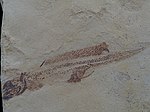   | |
| Bealbonn | B. rogaire | A gregoriid euchondrocephalan | |
| Belantsea | B. montana | A belantseid petalodontiform euchondrocephalan | |
| Carcharopsis | A putative euselachian shark | ||
| Cladodus | A "cladodont" | ||
| Cochliodus | C. contortus | A "cochliodont" holocephalan | |
| Damocles | D. serratus | A large Falcatus-like symoriiform | |
| Debeerius | D. ellefensi | A debeeriid euchondrocephalan | |
| Delphyodontos | D. dacriformes | An unusual holocephalan known from sharp-toothed fetuses | |
| Echinochimaera | E. meltoni | An echinochimaerid holocephalan | |
| E. snyderi | An echinochimaerid holocephalan | ||
| cf. Erismacanthus | E. maccoyanus | A putative "cochliodont" | |
| Falcatus | F. falcatus | A small and common symoriiform | |
| Fissodopsis | F. robustus | An obruchevodid petalodontiform | |
| Gregorius | G. rexi | A gregoriid | |
| Harpacanthus | H. fimbriatus | A euchondrocephalan with a tentaculated snout | |
| Harpagofututor | H. volsellorhinus | A long-bodied chondrenchelyiform holocephalan | |
| Heteropetalus | H. elegantulus | A slender debeeriid | |
| Janassa | J. clarki | A janassid petalodontiform | |
| Listracanthus | A spiny-backed chondrichthyan | ||
| Obruchevodus | O. griffithi | An obruchevodid petalodontiform | |
| Orestiacanthus | O. fergusi | A stethacanthid symoriiform | |
| Orodus | An orodontiform | ||
| Netsepoye | N. hawesi | An obruchevodid petalodontiform | |
| Papilionichthys | P. stahlae | An iniopterygian | |
| Petalorhynchus | P. beargulchensis | A petalorhynchid petalodontiform | |
| Polyrhizodus | P. digitatus | A petalodontid petalodontiform | |
| Psephodus | A "cochliodont" | ||
| Rainerichthys | R. zangerli | An iniopterygian | |
| Siksika | S. ottae | A basal petalodontiform | |
| Squatinactis | S. montanus | An unusual "cladodont" with broad pectoral fins, reminiscent of modern rays or angelsharks (Squatina) | |
| Srianta | S. dawsoni | A gregoriid | |
| S. iarlis | A gregoriid | ||
| S. srianta | A gregoriid | ||
| Stethacanthus | S. altonensis | A stethacanthid | |
| S. productus | A stethacanthid | ||
| Thrinacodus | T. gracia | An eel-like thrinacodontid elasmobranch, sometimes given its own genus, "Thrinacoselache" | |
| Traquairius | T. agkistrocephalus | A "cochliodont" | |
| T. nudus | A "cochliodont" | ||
| T. spinosus | A "cochliodont" | ||
| Tristychius | A tristychiid elasmobranch | ||
| Venustodus | V. argutus | A broad-toothed euchondrocephalan | |
Actinopterygians
Actinopterygians (ray-finned bony fish) are also quite diverse, with about 50 described and undescribed species (as of 2012) making up more than a third of the Bear Gulch fish diversity. In terms of specimen count, they are the most abundant fish fossils in the Bear Gulch Limestone, representing approximately 80% of all fossil vertebrates. However, they are more restricted than chondrichthyans in terms of ecomorphology. Most have a small and generalized fusiform (smoothly tapering) body shape, with only a few deviations towards more elongated or deep-bodied forms. The most abundant actinopterygians include Wendyichthys and three closely related unnamed species (code names "Yogo", "Fub", and "Cop"). The relative abundance of actinopterygians drops off in the upper bay, though they are still fairly common. Schools of freshly hatched larvae have been found in isolated reef habitats near the central basin.
| Ray-finned fish of the Bear Gulch Limestone | |||
|---|---|---|---|
| Taxon | Species | Notes | Images |
| Aesopichthys | A. erinaceus | An aesopichthyid "palaeoniscoid" |
  |
| Beagiascus | B. pulcherrimus | A "palaeoniscoid" | |
| Cyranorhis | C. bergeraci | A rhadinychthyid "palaeoniscoid" | |
| Discoserra | D. pectinodon | A guildayichthyiform | |
| Guildayichthys | G. carnegiei | A guildayichthyiform | |
| Kalops | K. diophrys | A "palaeoniscoid" | |
| K. monophrys | A "palaeoniscoid" | ||
| Lineagruan | L. judithi | A "palaeoniscoid" | |
| L. snowyi | A "palaeoniscoid" | ||
| Paphosiscus | P. circulocaudus | A paphosisciform "palaeoniscoid" | |
| P. scalmocristus | A paphosisciform | ||
| Paratarrasius | P. hibbardi | A tarrasiiform | |
| Proceramala | P. montanensis | An aesopichthyid | |
| Wendyichthys | W. dicksoni | A rhadinychthyid | |
| W. lautreci | A rhadinychthyid | ||
Other fish
Non-actinopterygian and non-chondrichthyan fish make up a fairly small component of the overall diversity, though their fossils are still common in some habitats. Preserved sarcopterygians (lobe-finned fish) include actinistians (coelacanths) and the rhizodont Strepsodus, which have very different habitat preferences. Coelacanths, particularly fossils of the genus Caridosuctor, are abundant in the central basin and its margins, but are practically absent in the upper bay. Strepsodus, on the other hand, is moderately common in the upper bay and very rare elsewhere. Neither are common in the sheltered eastern reef habitat. Acanthodes, the only acanthodian known from the Bear Gulch Limestone, has a similar distribution pattern to Strepsodus: common in the upper bay and nowhere else. Lampreys, represented by Hardistiella, are too rare to estimate their habitat preference.
| Fish of the Bear Gulch Limestone | |||
|---|---|---|---|
| Taxon | Species | Notes | Images |
| Acanthodes | A. lundi | An acanthodian |
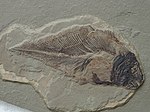 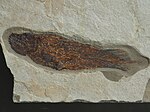 |
| Allenypterus | A. montanus | An unusual hadronectorid actinistian (early coelacanth) | |
| Caridosuctor | C. populosum | A rhabdodermatid actinistian | |
| Hadronector | H. donbairdi | A hadronectorid | |
| Hardistiella | H. montanensis | One of the oldest known petromyzontiforms (lampreys) | |
| Lochmocercus | L. aciculodontus | An indeterminate actinistian | |
| Polyosteorhynchus | P. beargulchensis | A hadronectorid | |
| Strepsodus | A rhizodont | ||
Arthropods
Arthropods are diverse, the most abundant and speciose being various early hoplocarids, relatives of modern stomatopods (mantis shrimps). Other arthropods include an assortment of typical Carboniferous crustaceans, rare xiphosurans (horseshoe crabs), and a single "synziphosurine" (Anderella). Trilobites, though common in adjacent formations, are practically absent in the Bear Gulch Limestone.
| Arthropods of the Bear Gulch Limestone | |||
|---|---|---|---|
| Genus | Species | Notes | Images |
| Aenigmacaris | A. cornigerum | An aeschronectid hoplocarid |
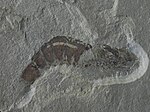  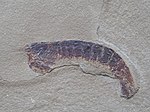  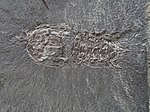 |
| Anderella | A. parva | The youngest known "synziphosurine" ( a group of xiphosuran-like chelicerates) | |
| Bairdops | B. beargulchensis | A possibly paraphyletic "palaeostomatopod" (primitive hoplocarid), often considered a relative of Perimecturus, and at one point a junior synonym of Tyrannophontes | |
| Belotelson | B. magister | A belotelsonid shrimp | |
| Concavicarida indet. | An indeterminate concavicarid, possibly referable to Ankitokazocaris or Concavicaris | ||
| Crangopsis | C. eskdalensis | A rare aeschronectid hoplocarid | |
| Daidal | D. acanthocercus | An "archaeostomatopod" (hoplocarid closely related to modern mantis shrimps), previously referred to Tyrannophontes theridion and sometimes considered its own species of Tyrannophontes. | |
| Dithyrocaris | D. rolfei | A large phyllocarid shrimp | |
| Euproops | E. sp. | A rare xiphosuran (early horseshoe crab) | |
| Ostracoda indet. | Indeterminate and very rare ostracods | ||
| "Paleolimulus" | "P". longispinus | A xiphosuran with uncertain classification | |
| "Perimecturus" | "P." rapax | A possibly polyphyletic "palaeostomatopod" (primitive hoplocarid), often considered a relative of Bairdops | |
| Sairocaris | S. centurion | A probable phyllocarid shrimp | |
| Schramine | S. montanaensis | One of the oldest of the crab-like cycloid crustaceans, previously considered a species of Halicyne | |
| Titanoprosoma | T. edgecombei | A simplified arthropod tentatively identified as a euchelicerate. | |
Molluscs
| Molluscs of the Bear Gulch Limestone | |||
|---|---|---|---|
| Taxon | Species | Notes | Images |
| Bivalvia sp. | Several unnamed or undescribed species of bivalves, including scallop-like (Aviculopecten?) and mussel-like (Myalina?) forms. Some encrusting pterioid bivalves (Caneyella, Ptychopteria) have been found attached to strands of sargassum-like brown algae. |
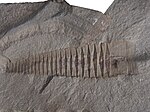 | |
| Cephalopoda sp. | Various cephalopods, which are locally abundant in the Bear Gulch Limestone. They include coiled nautiloids (Anthracoceras, Epistroboceras, Tylonautilus), orthoconic (straight-shelled) nautiloids (Reticycloceras), ammonoids (Fayettevillea, Eumorphoceras, Metadimorphoceras), vampyropods (Syllipsimopodi), and coleoids (Gordoniconus, etc.). | ||
| Gastropoda sp. | Unnamed or undescribed species of gastropods (sea snails), which are only common in marginal facies | ||
Worms
"Nemavermes mackeei" is a worm-shaped fossil originally known from the Mazon Creek fossil beds of Illinois, and later reported from Bear Gulch. Initially described as a free-swimming nematode, a 2023 reinvestigation indicated that the holotype of Nemavermes mackeei from Mazon Creek is actually a detached proboscis of Tullimonstrum. Other "Nemavermes" fossils from Mazon Creek are actually lamprey-like cyclostome fish, named as the new genus and species Squirmarius testai. The true identities of the Bear Gulch "Nemavermes" fossils are ambiguous.
| Worms of the Bear Gulch Limestone | ||
|---|---|---|
| Genus | Species | Notes |
| Archisymplectes | A. rhothon | A nemertine (ribbon worm) |
| Astreptoscolex | A. anasillosus | A nephtyid polychaete worm |
| Brochosogenys | B. reidiae | A kielanoprionid polychaete |
| Carbosesostris | C. megaliphagon | A goniadid polychaete |
| Deuteronectanebos | D. papillorum | An indeterminate worm |
| Phiops | P. aciculorum | A lumbrinerid polychaete |
| Ramesses | R. magnus | An indeterminate polychaete |
| Soris | S. labiosus | An indeterminate polychaete |
| Symmetroprion | S. sp. | A symmetroprionid polychaete |
Other invertebrates
| Invertebrates of the Bear Gulch Limestone | |||
|---|---|---|---|
| Genus / Taxon | Species | Notes | Images |
| Brachiopoda sp. | Several unnamed or undescribed species of brachiopods, including productids, spiriferids, Orbiculoidea, and Lingula. Small and large spiny productids are common encrusters on other organisms. |
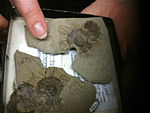  | |
| Bryozoa sp. | Very rare and undescribed encrusting bryozoans, including Pycnopora regularis and Discretella robusta. | ||
| Conodonta sp. | Various conodonts, only recovered from coprolites or gut content of Typhloesus. May include Lochriea, Kladognathus, Gnathodus, and Cavusgnathus. | ||
| Echinodermata sp. | Various rare echinoderms, including unnamed or undescribed species of crinoids, echinoids (sea urchins), ophiuroids (brittle stars), and asteroids (sea stars). The only moderately common echinoderm is Lepidasterella montanensis, a many-armed sea star. | ||
| Paraconularia | P. subulata | A conulariid | |
| Porifera sp. | Various rare to locally abundant sea sponges, including hexactinellids, Norfordia, and Belemnospongia. By far the most abundant is Arborispongia delicatula, a ramose (branching) sponge which serves as the foundation for complex reef-like ecosystems. | ||
| Sphenothallus | A common but enigmatic organism with a strand-like tubular shape, possibly represented by multiple species. May be related to cnidarians or conulariids. | ||
| "Square objects" | Very common but enigmatic barrel-shaped planktonic organisms, possibly salps or cnidarians | ||
| Typhloesus | T. wellsi | An unusual swimming invertebrate originally mistaken for large conodonts ("Lochriea wellsi", "Scottognathus elizabethi") with complex jaws. Conodont elements are now understood to be gut content. Often interpreted as a deuterostome, but recently reinterpreted as a heteropod-like gastropod. | |
See also
External links
- Personal website of Richard Lund and Eileen Grogan, exhibiting the Bear Gulch Limestone and its fossils
- 1998 Discovery Channel documentary "Prehistoric Sharks", featuring a segment on Bear Gulch (4:36-16:13)
- Segment of the 2020 PBS documentary "Prehistoric Road Trip", focusing on the Bear Gulch fossils (12:16-22:53)
References
- ^ Williams, Loretta Ann (1983). "Deposition of the Bear Gulch Limestone: a Carboniferous Plattenkalk from central Montana". Sedimentology. 30 (6): 843–860. Bibcode:1983Sedim..30..843W. doi:10.1111/j.1365-3091.1983.tb00714.x. ISSN 1365-3091.
- ^ Grogan, Eileen D.; Lund, Richard (2002). "The geological and biological environment of the Bear Gulch Limestone (Mississippian of Montana, USA) and a model for its deposition" (PDF). Geodiversitas. 24 (2): 295–315.
- ^ Lund, Richard; Poplin, Cécile (1999-01-01). "Fish diversity of the Bear Gulch Limestone, Namurian, Lower Carboniferous of Montana, USA". Geobios. 32 (2): 285–295. doi:10.1016/S0016-6995(99)80042-4. ISSN 0016-6995.
- ^ Lund, Richard; Greenfest-Allen, Emily; Grogan, Eileen D. (2015-02-01). "Ecomorphology of the Mississippian fishes of the Bear Gulch Limestone (Heath formation, Montana, USA)". Environmental Biology of Fishes. 98 (2): 739–754. doi:10.1007/s10641-014-0308-x. ISSN 1573-5133. S2CID 14850973.
- ^ Janvier, Philippe; Lund, Richard (1983). "Hardistiella montanensis n. gen. et sp. (Petromyzontida) from the Lower Carboniferous of Montana, with remarks on the affinities of the lampreys". Journal of Vertebrate Paleontology. 2 (4): 407–413. doi:10.1080/02724634.1983.10011943. ISSN 0272-4634.
- ^ Lund, Richard; Greenfest-Allen, Emily; Grogan, Eileen D. (2012-07-15). "Habitat and diversity of the Bear Gulch fish: Life in a 318 million year old marine Mississippian bay". Palaeogeography, Palaeoclimatology, Palaeoecology. 342–343: 1–16. Bibcode:2012PPP...342....1L. doi:10.1016/j.palaeo.2012.04.016. ISSN 0031-0182.
- ^ Klug, Christian; Landman, Neil H.; Fuchs, Dirk; Mapes, Royal H.; Pohle, Alexander; Guériau, Pierre; Reguer, Solenn; Hoffmann, René (2019-07-31). "Anatomy and evolution of the first Coleoidea in the Carboniferous". Communications Biology. 2 (1): 280. doi:10.1038/s42003-019-0523-2. ISSN 2399-3642. PMC 6668408. PMID 31372519.
- ^ Whalen, Christopher D.; Landman, Neil H. (2022-03-08). "Fossil coleoid cephalopod from the Mississippian Bear Gulch Lagerstätte sheds light on early vampyropod evolution". Nature Communications. 13 (1): 1107. doi:10.1038/s41467-022-28333-5. ISSN 2041-1723. PMC 8904582. PMID 35260548.
- ^ Lund, Richard (1990-01-01). "Chondrichthyan life history styles as revealed by the 320 million years old Mississippian of Montana". Environmental Biology of Fishes. 27 (1): 1–19. doi:10.1007/BF00004900. ISSN 1573-5133. S2CID 13249799.
- ^ Mapes, Royal H.; Landman, Neil H.; Klug, Christian (2019-03-01). "Caught in the act? Distraction sinking in ammonoid cephalopods". Swiss Journal of Palaeontology. 138 (1): 141–149. doi:10.1007/s13358-018-0176-7. ISSN 1664-2384. S2CID 135122075.
- ^ Grogan, Eileen D.; Lund, Richard (1997). "Soft tissue pigments of the Upper Mississippian chondrenchelyid, Harpagofututor volsellorhinus (Chondrichthyes, Holocephali) from the Bear Gulch Limestone, Montana, USA". Journal of Paleontology. 71 (2): 337–342. doi:10.1017/S002233600003924X. ISSN 0022-3360. S2CID 131227701.
- ^ Eileen D. Grogan & Richard Lund (2000). "Debeerius ellefseni (fam. nov., gen. nov., spec. nov.), an autodiastylic chondrichthyan from the Mississippian Bear Gulch Limestone of Montana (USA), the relationships of the chondrichthyes, and comments on gnathostome evolution". Journal of Morphology. 243 (3): 219–245. doi:10.1002/(SICI)1097-4687(200003)243:3<219::AID-JMOR1>3.0.CO;2-1. PMID 10681469. S2CID 21466183.
- ^ Conway Morris, Simon (1990-04-12). "Typhloesus wellsi (Melton and Scott, 1973), a bizarre metazoan from the Carboniferous of Montana, U. S. A". Philosophical Transactions of the Royal Society of London. B, Biological Sciences. 327 (1242): 595–624. Bibcode:1990RSPTB.327..595M. doi:10.1098/rstb.1990.0102.
- ^ Feldman, Howard R.; Lund, Richard; Maples, Christopher G.; Archer, Allen W. (1994-06-01). "Origin of the Bear Gulch Beds (Namurian, Montana, USA)". Geobios. 27: 283–291. doi:10.1016/S0016-6995(94)80045-6. ISSN 0016-6995.
- ^ Hagadorn, James W. (2002). "Bear Gulch: An Exceptional Upper Carboniferous Plattenkalk". In Bottjer, D.J.; Etter, W.; Hagadorn, J.W.; Tang, C.M. (eds.). Exceptional fossil preservation; a unique view on the evolution of marine life. New York: Columbia University Press. pp. 167–183.
- Maughan, Edwin K. (1984-02-01). "Paleogeographic Setting of Pennsylvanian Tyler Formation and Relation to Underlying Mississippian Rocks in Montana and North Dakota1". AAPG Bulletin. 68 (2): 178–195. doi:10.1306/AD4609F9-16F7-11D7-8645000102C1865D. ISSN 0149-1423.
- ^ Singer, Amy; Stanley, George D.; Hinman, Nancy W. (2019-02-24). "Anatomy of the Book Canyon conglomerate: a sequence boundary at the top of the Bear Gulch Limestone in the Big Snowy Trough". Facies. 65 (2): 15. doi:10.1007/s10347-019-0557-4. ISSN 1612-4820. S2CID 135197751.
- ^ Cox, Robt S. (1986). "Preliminary report on the age and palynology of the Bear Gulch Limestone (Mississippian, Montana)". Journal of Paleontology. 60 (4): 952–956. doi:10.1017/S0022336000043092. ISSN 0022-3360. S2CID 130548212.
- Pointon, Michael A.; Chew, David M.; Ovtcharova, Maria; Sevastopulo, George D.; Crowley, Quentin G. (2012-11-01). "New high-precision U–Pb dates from western European Carboniferous tuffs; implications for time scale calibration, the periodicity of late Carboniferous cycles and stratigraphical correlation". Journal of the Geological Society. 169 (6): 713–721. Bibcode:2012JGSoc.169..713P. doi:10.1144/jgs2011-092. hdl:2262/79149. ISSN 0016-7649. S2CID 129867190.
- Jirásek, Jakub; Opluštil, Stanislav; Sivek, Martin; Schmitz, Mark D.; Abels, Hemmo A. (2018-02-01). "Astronomical forcing of Carboniferous paralic sedimentary cycles in the Upper Silesian Basin, Czech Republic (Serpukhovian, latest Mississippian): New radiometric ages afford an astronomical age model for European biozonations and substages". Earth-Science Reviews. 177: 715–741. Bibcode:2018ESRv..177..715J. doi:10.1016/j.earscirev.2017.12.005. ISSN 0012-8252.
- Grogan, Eileen D.; Lund, Richard (1995-01-01). "Pigment patterns; soft anatomy and relationships of Bear Gulch Chondrichthyes (Namurian E2b; Lower Carboniferous; Montana; USA)". Geobios. Premiers Vertandébrandés et Vertandébrandés Infandérieurs. 28: 145–146. doi:10.1016/S0016-6995(95)80102-2. ISSN 0016-6995.
- Grogan, Eileen D.; Lund, Richard (2008-12-12). "A basal elasmobranch, Thrinacoselache gracia n. gen and sp., (Thrinacodontidae, new family) from the Bear Gulch Limestone, Serpukhovian of Montana, USA". Journal of Vertebrate Paleontology. 28 (4): 970–988. doi:10.1671/0272-4634-28.4.970. ISSN 0272-4634. S2CID 84735866.
- ^ McRoberts, Christopher A.; Stanley, George D. (1989). "A unique bivalve–algae life assemblage from the Bear Gulch Limestone (Upper Mississippian) of central Montana". Journal of Paleontology. 63 (5): 578–581. doi:10.1017/S0022336000041214. ISSN 0022-3360. S2CID 131030155.
- ^ Lund, Richard; Grogan, Eileen D. (2004). "Five new euchondrocephalan Chondrichthyes from the Bear Gulch Limestone (Serpukhovian, Namurian E2b) of Montana, USA" (PDF). In Arratia, G.; Wilson, M.V.H.; Cloutier, R. (eds.). Recent Advances in the Origin and Early Radiation of Vertebrates. München: Verlag Dr. Friedrich Pfeil. pp. 505–531.
- ^ Grogan, Eileen D.; Lund, Richard (2008). "A basal elasmobranch, Thrinacoselache gracia n. gen and sp., (Thrinacodontidae, new family) from the Bear Gulch Limestone, Serpukhovian of Montana, USA". Journal of Vertebrate Paleontology. 28 (4): 970–988. doi:10.1671/0272-4634-28.4.970. S2CID 84735866.
- ^ Lund, Richard (1989-09-28). "New petalodonts (Chondrichthyes) from the Upper Mississippian Bear Gulch Limestone (Namurian E2b) of Montana". Journal of Vertebrate Paleontology. 9 (3): 350–368. doi:10.1080/02724634.1989.10011767. ISSN 0272-4634.
- ^ Lund, R.; Grogan, E. D.; Fath, M. (2014-12-01). "On the relationships of the Petalodontiformes (Chondrichthyes)". Paleontological Journal. 48 (9): 1015–1029. doi:10.1134/S0031030114090081. ISSN 1555-6174. S2CID 84617203.
- ^ Lund, R.; Grogan, E.D. (1997). "Cochliodonts from the Mississippian Bear Gulch Limestone (Heath Formation; Big Snowy Group; Chesterian) of Montana and the relationships of the Holocephali". Dinofest International Symposium, Proceedings: 477–492.
- ^ Lund, Richard (1986-03-07). "On Damocles serratus, nov. gen. et sp. (Elasmobranchii: Cladodontida) from the Upper Mississippian Bear Gulch Limestone of Montana". Journal of Vertebrate Paleontology. 6 (1): 12–19. doi:10.1080/02724634.1986.10011594. ISSN 0272-4634.
- Lund, Richard (1980-08-08). "Viviparity and Intrauterine Feeding in a New Holocephalan Fish from the Lower Carboniferous of Montana". Science. 209 (4457): 697–699. Bibcode:1980Sci...209..697L. doi:10.1126/science.209.4457.697. PMID 17821193. S2CID 36858963.
- Lund, Richard (1977). "Echinochimaera meltoni new genus and species (Chimaeriformes) from the Mississippian of Montana". Annals of Carnegie Museum. 46: 195–221. doi:10.5962/p.330529. S2CID 251525608.
- Lund, R. 1988. New Mississippian Holocephali (Chondrichthyes) and the evolution of the Holocephali. In Teeth Revisited: Proceedings of the VII Int. Symp. on Dental Morph., Paris, May 1986, Russell, D. E., Santoro, J. P. and Sigogneau‑Russell, D., Eds., Mem. Mus. Natn. Hist. Nat., Paris, (serie C) 53:195‑205.
- ^ Lund, Richard (1985-03-01). "The morphology of Falcatus falcatus (St. John and Worthen), a Mississippian stethacanthid chondrichthyan from the Bear Gulch Limestone of Montana". Journal of Vertebrate Paleontology. 5 (1): 1–19. doi:10.1080/02724634.1985.10011842. ISSN 0272-4634.
- ^ Lund, Richard; Grogan, Eileen D. (2004). "Two tenaculum-bearing Holocephalimorpha (Chondrichthyes) from the Bear Gulch Limestone (Chesterian, Serpukhovian) of Montana, USA" (PDF). In Arratia, G.; Wilson, M.V.H.; Cloutier, R. (eds.). Recent Advances in the Origin and Early Radiation of Vertebrates. München: Verlag Dr. Friedrich Pfeil. pp. 171–187.
- Lund, Richard (1982). "Harpagofututor volsellorhinus New Genus and Species (Chondrichthyes, Chondrenchelyiformes) from the Namurian Bear Gulch Limestone, Chondrenchelys problematica Traquair (Visean), and Their Sexual Dimorphism". Journal of Paleontology. 56 (4): 938–958. ISSN 0022-3360. JSTOR 1304712.
- Lund, Richard (1977). "A new petalodont (Chondrichthyes, Bradyodonti) from the Upper Mississippian of Montana". Annals of Carnegie Museum. 46: 129–155. doi:10.5962/p.330526. S2CID 251529786.
- Grogan, E. D.; Lund, R.; Fath, M. (2014-12-01). "A new petalodont chondrichthyan from the bear gulch limestone of montana, USA, with reassessment of Netsepoye hawesi and comments on the morphology of holomorphic petalodonts". Paleontological Journal. 48 (9): 1003–1014. doi:10.1134/S0031030114090044. ISSN 1555-6174. S2CID 84238164.
- ^ Lund, Richard (1984-01-01). "On the spines of the Stethacanthidae (Chondrichthyes), with a description of a new genus from the Mississippian Bear Gulch limestone". Geobios. 17 (3): 281–295. doi:10.1016/S0016-6995(84)80095-9. ISSN 0016-6995.
- ^ Grogan, Eileen D.; Lund, Richard (2009). "Two new iniopterygians (Chondrichthyes) from the Mississippian (Serpukhovian) Bear Gulch Limestone of Montana with evidence of a new form of chondrichthyan neurocranium". Acta Zoologica. 90 (s1): 134–151. doi:10.1111/j.1463-6395.2008.00371.x. ISSN 1463-6395.
- Lund, Richard (1983-03-01). "On a dentition of Polyrhizodus (Chondrichthyes, Petalodontiformes) from the Namurian bear gulch limestone of Montana". Journal of Vertebrate Paleontology. 3 (1): 1–6. doi:10.1080/02724634.1983.10384478. ISSN 0272-4634.
- Lund, Richard; Zangerl, Rainer (1974). "Squatinactis caudispinatus, a new elasmobranch from the Upper Mississippian of Montana". Annals of Carnegie Museum. 45: 43–54. doi:10.5962/p.330504. S2CID 251537092.
- Lund, Richard (1988). "New Information on Squatinactis caudispinatus (Chondrichthyes, Cladodontida) from the Chesterian Bear Gulch Limestone of Montana". Journal of Vertebrate Paleontology. 8 (3): 340–342. doi:10.1080/02724634.1988.10011718. ISSN 0272-4634. JSTOR 4523212.
- Lund, Richard (1974). "Stethacanthus altonensis (Elasmobranchii) from the Bear Gulch Limestone of Montana". Annals of Carnegie Museum. 45: 161–178. doi:10.5962/p.330508. S2CID 251532925.
- ^ Lund, Richard (1985). "Stethacanthid elasmobranch remains from the Bear Gulch Limestone (Namurian E2b) of Montana". American Museum Novitates (2828): 1–24. hdl:2246/3554.
- Ginter, Michał; Turner, Susan (2010-12-02). "The middle Paleozoic Selachian genus Thrinacodus". Journal of Vertebrate Paleontology. 30 (6): 1666–1672. doi:10.1080/02724634.2010.520785. ISSN 0272-4634. S2CID 86058786.
- Frey, Linda; Coates, Michael; Ginter, Michał; Hairapetian, Vachik; Rücklin, Martin; Jerjen, Iwan; Klug, Christian (2019-10-09). "The early elasmobranch Phoebodus: phylogenetic relationships, ecomorphology and a new time-scale for shark evolution". Proceedings of the Royal Society B: Biological Sciences. 286 (1912): 20191336. doi:10.1098/rspb.2019.1336. PMC 6790773. PMID 31575362.
- ^ Poplin, Cécile; Lund, Richard (2000-09-25). "Two new deep-bodied palaeoniscoid actinopterygians from Bear Gulch (Montana, USA, Lower Carboniferous)". Journal of Vertebrate Paleontology. 20 (3): 428–449. doi:10.1671/0272-4634(2000)020[0428:tndbpa]2.0.co;2. ISSN 0272-4634. S2CID 85632076.
- ^ Mickle, Kathryn E.; Lund, Richard; Grogan, Eileen D. (2009). "Three new palaeoniscoid fishes from the Bear Gulch Limestone (Serpukhovian, Mississippian) of Montana (USA) and the relationships of lower actinopterygians". Geodiversitas. 31 (3): 623–668. doi:10.5252/g2009n3a6. ISSN 1280-9659. S2CID 128412802.
- ^ Lund, Richard; Poplin, Cécile (1997-09-04). "The rhadinichthyids (paleoniscoid actinopterygians) from the Bear Gulch Limestone of Montana (USA, Lower Carboniferous)". Journal of Vertebrate Paleontology. 17 (3): 466–486. doi:10.1080/02724634.1997.10010996. ISSN 0272-4634.
- ^ Lund, Richard (2000). "The new Actinopterygian order Guildayichthyiformes from the Lower Carboniferous of Montana (USA)" (PDF). Geodiversitas. 22 (2): 171–206.
- Poplin, C. M.; Lund, R. (2002). "Two Carboniferous fine-eyed palaeoniscoids (Pisces, Actinopterygii) from Bear Gulch (USA)". Journal of Paleontology. 76 (6): 1014–1028. doi:10.1017/s002233600005784x. ISSN 0022-3360. S2CID 232348836.
- Grogan, Eileen D.; Lund, Richard (2015). "Two new Actinopterygii (Vertebrata, Osteichthyes) with cosmine from the Bear Gulch Limestone (Heath Fm., Serpukhovian, Mississippian) of Montana USA". Proceedings of the Academy of Natural Sciences of Philadelphia. 164 (1): 111–132. doi:10.1635/053.164.0114. ISSN 0097-3157. S2CID 130093887.
- Lund, Richard; Melton, William G. Jr. (1982). "A new actinopterygian fish from the Mississippian Bear Gulch Limestone of Montana". Palaeontology. 25 (3): 485–498.
- Lund, Richard; Poplin, Cécile (2002-09-19). "Cladistic analysis of the relationships of the Tarrasiids (Lower Carboniferous Actinopterygians)". Journal of Vertebrate Paleontology. 22 (3): 480–486. doi:10.1671/0272-4634(2002)022[0480:caotro]2.0.co;2. ISSN 0272-4634. S2CID 86148802.
- Zidek, Jiri (1980). "Acanthodes lundi, new species (Acanthodii) and associated coprolites from uppermost Mississippian Heath Formation of Central Montana". Annals of Carnegie Museum. 49 (3): 49–78. doi:10.5962/p.214478. S2CID 90673484.
- ^ Lund, Richard; Lund, Wendy (1984). "New genera and species of coelacanths from the Bear Gulch Limestone (Lower Carboniferous) of Montana (U.S.A.)". Geobios. 17 (2): 237–244. doi:10.1016/s0016-6995(84)80145-x. ISSN 0016-6995.
- ^ Lund, Richard; Lund, Wendy Laurie (1985). "Coelacanths from the Bear Gulch Limestone (Namurian) of Montana and the evolution of the Coelacanthiformes". Bulletin of Carnegie Museum of Natural History. 25: 1–74. doi:10.5962/p.228604. S2CID 251487945.
- Janvier, Philippe; Lund, Richard; Grogan, Eileen D. (2004-09-10). "Further consideration of the earliest known lamprey, Hardistiella montanensis Janvier and Lund, 1983, from the Carboniferous of Bear Gulch, Montana, U.S.A.". Journal of Vertebrate Paleontology. 24 (3): 742–743. doi:10.1671/0272-4634(2004)024[0742:fcotek]2.0.co;2. ISSN 0272-4634. S2CID 131704031.
- ^ Factor, David F.; Feldmann, Rodney M. (11 October 1985). "Systematics and paleoecology of malacostracan arthropods in the Bear Gulch Limestone (Namurian) of Central Montana". Annals of Carnegie Museum. 54 (10): 319–356. doi:10.5962/p.330776. S2CID 251522559.
- ^ Jenner, Ronald A.; Hof, Cees H.J.; Schram, Frederick R. (1998). "Palaeo- and archaeostomatopods (Hoplocarida, Crustacea) from the Bear Gulch Limestone, Mississippian (Namurian), of central Montana". Contributions to Zoology. 67 (3): 155–185. doi:10.1163/18759866-06703001. ISSN 1383-4517.
- ^ Schram, Frederick R.; Horner, John (1978). "Crustacea of the Mississippian Bear Gulch Limestone of Central Montana". Journal of Paleontology. 52 (2): 394–406. ISSN 0022-3360. JSTOR 1303712.
- ^ Schrams, Frederick R. (1979). "Limulines of the Mississippian Bear Gulch Limestone of Central Montana, USA". Transactions of the San Diego Society of Natural History. 19 (6): 67–74.
- ^ Moore, Rachel A.; McKenzie, Scott C.; Lieberman, Bruce S. (2007). "A Carboniferous synziphosurine (Xiphosura) from the Bear Gulch Limestone, Montana, USA" (PDF). Palaeontology. 50 (4): 1013–1019. doi:10.1111/j.1475-4983.2007.00685.x. ISSN 1475-4983. S2CID 59449700.
- ^ Schram, Frederick R. (1979). "The genus Archaeocaris, and a general review of the Paleostomatopoda (Hoplocarida: Malacostraca)". Transactions of the San Diego Society of Natural History. 19 (5): 57–66.
- ^ SCHRAM, FREDERICK R. (2007-09-01). "Paleozoic Proto-Mantis Shrimp Revisited". Journal of Paleontology. 81 (5): 895–916. doi:10.1666/pleo05-075.1. ISSN 0022-3360. S2CID 85606671.
- Schram, Frederick R. (2014-01-01). "Family level classification within Thylacocephala, with comments on their evolution and possible relationships". Crustaceana. 87 (3): 340–363. doi:10.1163/15685403-00003289. ISSN 1568-5403.
- Bicknell, Russell D. C.; Naugolnykh, Serge V.; Birch, Sienna A. (2020-10-03). "A reappraisal of Paleozoic horseshoe crabs from Russia and Ukraine". The Science of Nature. 107 (5): 46. doi:10.1007/s00114-020-01701-1. ISSN 1432-1904.
- ^ Schram, Frederick R.; Boere, Arjan C.; Thomas, Natalie (2006-01-05). "Cycloidea of the Mississippian Bear Gulch Limestone of central Montana". Contributions in Science. 504: 1–8. doi:10.5962/p.210567. ISSN 0459-8113. S2CID 160017485.
- Dzik, Jerzy (2008). "Gill structure and relationships of the Triassic cycloid crustaceans". Journal of Morphology. 269 (12): 1501–1519. doi:10.1002/jmor.10663. ISSN 1097-4687. PMID 18690662. S2CID 17617567.
- ^ Bicknell, Russell D.C.; Kimmig, Julien; Smith, Patrick M.; Torsten, Scheyer (1 February 2024). "An enigmatic euchelicerate from the Mississippian (Serpukhovian) and insights into invertebrate preservation in the Bear Gulch Limestone, Montana". American Museum Novitates. 4008: 1–14.
- ^ Mapes, Royal H. (1987). "Upper Paleozoic cephalopod mandibles: frequency of occurrence, modes of preservation, and paleoecological implications". Journal of Paleontology. 61 (3): 521–538. doi:10.1017/S0022336000028687. ISSN 0022-3360. S2CID 133533107.
- Whalen, C. D.; Landman, N. H. (2022). "Fossil coleoid cephalopod from the Mississippian Bear Gulch Lagerstätte sheds light on early vampyropod evolution". Nature Communications. 13 (1): Article number 1107. doi:10.1038/s41467-022-28333-5. PMC 8904582. PMID 35260548.
- Klug, C.; Stevens, K.; Hoffmann, R.; Zatoń, M.; Clements, T.; Košťák, M.; Weis, R.; De Baets, K.; Lehmann, J.; Vinther, J.; Fuchs, D. (2023). "Revisiting the identification of Syllipsimopodi bideni and timing of the decabrachian-octobrachian divergence". Nature Communications. 14 (1). 8094. doi:10.1038/s41467-023-42842-x. PMC 10703834. PMID 38062003.
- Whalen, C. D.; Landman, N. H. (2023). "Reply to: Revisiting the identification of Syllipsimopodi bideni and timing of the decabrachian-octobrachian divergence". Nature Communications. 14 (1). 8228. doi:10.1038/s41467-023-42843-w. PMC 10716472. PMID 38086818.
- ^ Schram, Frederick R. (1979). "Worms of the Mississippian Bear Gulch Limestone of Central Montana, USA". Transactions of the San Diego Society of Natural History. 19 (9): 107–120.
- McCoy, Victoria E.; Wittry, Jack; Sadabadi, Hamed; Mayer, Paul (September 2023). "A reappraisal of Nemavermes mackeei from the Mazon Creek fossil site expands Carboniferous cyclostome diversity". Journal of Paleontology. 97 (5): 1116–1132. doi:10.1017/jpa.2023.72. ISSN 0022-3360.
- ^ Thomas, Natalie (2004). The Taphonomy of a Carboniferous Lagerstatte: the Invertebrates of the Bear Gulch Limestone Member. University of Leicester thesis (thesis).
- Purnell, Mark A. (1993-04-01). "Feeding mechanisms in conodonts and the function of the earliest vertebrate hard tissues". Geology. 21 (4): 375–377. Bibcode:1993Geo....21..375P. doi:10.1130/0091-7613(1993)021<0375:FMICAT>2.3.CO;2. ISSN 0091-7613.
- Welch, James R. (1984). "The Asteroid, Lepidasterella montanensis n. sp., from the Upper Mississippian Bear Gulch Limestone of Montana". Journal of Paleontology. 58 (3): 843–851. ISSN 0022-3360. JSTOR 1304921.
- Babcock, Loren E.; Feldmann, Rodney M. (1986). "Devonian and Mississippian conulariids of North America. part B. Paraconularia, Reticulaconularia, New Genus, and organisms rejected from Conulariida". Annals of Carnegie Museum. 55: 411–479. doi:10.5962/p.215204. S2CID 251525208.
- Iten, Heyo Van; Cox, Robt S.; Mapes, Royal H. (1992). "New data on the morphology of Sphenothallus Hall: implications for its affinities". Lethaia. 25 (2): 135–144. doi:10.1111/j.1502-3931.1992.tb01378.x. hdl:2027.42/73676. ISSN 1502-3931.
- Conway Morris, Simon; Caron, Jean-Bernard (2022). "A possible home for a bizarre Carboniferous animal: is Typhloesus a pelagic gastropod?". Biology Letters. 18 (9): 20220179. doi:10.1098/rsbl.2022.0179. PMC 9489302. PMID 36126687.